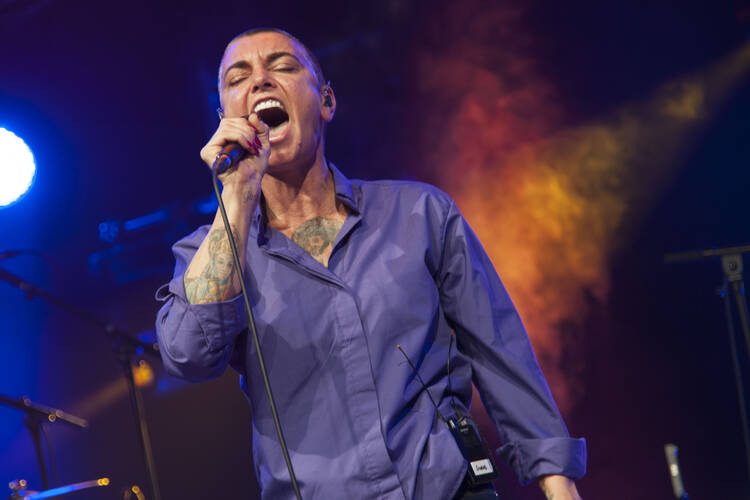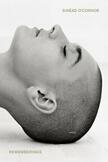Sinéad O’Connor longs for transcendence in ‘Rememberings’
Sinéad O’Connor’s new memoir, Rememberings, is a revelation, full of beauty and spiritual vitality with flashes of humor and sheer irreverence. From fans in the 1990s, like me, who sang their hearts out to every line of every song in the album “I Do Not Want What I Haven’t Got,” to those who only vaguely know her name from the controversy that ensued in 1992 after she ripped up a photograph of Pope John Paul II during her performance on “Saturday Night Live,” there is something in Rememberings for everyone.
What may stand out most to readers of America is the fact that despite O’Connor’s reputation, arguably the heartbeat of the memoir is her sense of transcendence and her longing for it, as well as the depth of her religious imagination since childhood. She is famously hard to place religiously—a critic of institutional religion and a recent convert to Islam. But her memoir shows that her religious eclecticism is not the stuff of the lighter “spiritual but not religious” fare that is standard in consumer capitalism, with its predictable heroes and villains. Hers is made of serious stuff, tough stuff.
O’Connor doesn’t hide much of her story. She describes her childhood with a pious, devout but horrendously abusive mother, as well as time spent in a convent with Catholic nuns—some of whom were kind to her, encouraging her as a musician, and others predictably cruel (she calls her Irish upbringing as growing up in a “theocracy”). She also writes of the occasional sweet priest who offered her forgiveness as a child when she stole, lied or ran away.
There is much trauma in the story of her life, but O’Connor doesn’t wallow in it or ground her authority as an artist in it.
As an adult artist, she took matters of the spirit into her own hands. Her first two albums are shot through with thoughts about death, while her later albums center on healing and forgiveness. Most religiously significant is her 2007 work “Theology,” an album, she tells us, “that I had wanted to make since I was seven years old....” She writes, “When I go out in a coffin it is the only album I am bringing with me.”
We learn that “Theology” was created after she spent the year 2000 studying theology at a university. There she was particularly taken with a priest who taught her the Hebrew Bible; he was able to “bring God off the page,” she writes. He encouraged O’Connor to do the same with her songs. So she transcribed her favorite lines from various books of the Hebrew Bible, rearranged them, made some adjustments for rhyming and created a full album from them.
The most beautiful songs on “Theology” include “Whomsoever Dwells,” based on Psalm 91, and “33,” based on Psalm 33. (One can see wonderful videos of her singing these songs live on YouTube). It was the psalms, as she put it, that “let everyone see the humanity of God, the vulnerability, the moodiness, the emotionality.”
But in the process of writing her life story, O’Connor realized that beyond the obviously religious “Theology,” she had written other songs with familiar themes. “There’s an awful lot of songs about belief in the spirit world,” she writes. “There are songs that are concerned with the idea that the Gospels are indeed such, and the Scriptures of old are true. And that there is no such thing as death, which is what all God’s messengers have told us, no matter what religion they come from.”
The world had no narrative, no frame of reference in which to place a theologically sophisticated rebel, especially this part of her. We can hardly call her a Christian rocker—there is nothing cheesy in her songs, and nothing is scrubbed out in the cause of some moral narrative arc. She doesn’t relish her suffering either. She is unabashed about the role marijuana plays in her life, and despite her traumas, she celebrates her life and joys and even her body. There are many songs and reminiscences about her lovers, about how good she feels with her makeup looking nice, her shaved head, her “boobs upright,” and her unadulterated love of her four babies, now grown children (while admitting she wasn’t always the world’s perfect mother).
Hers is the story of a confident seeker of transcendence answering to a higher calling, a nonconformist who refused to surrender to the role of the sexy pop artist or the pious singer-songwriter. When “Theology” appeared in 2007, dismissive, mocking reviews like this in Rolling Stone were typical: “How awesome is it being God? Not only do you get Sinead to praise you in her reggae hymn ‘The Glory of Jah,’ you get a bonus acoustic version! Damn, Jah—that’s a heck of a lot of glory!”
They simply did not get it or her. Looking back, looking at old video clips and pictures of O’Connor wearing a priest’s collar, crosses or, now, a hijab, it wasn’t a mockery but a reclamation of language and symbols that have been central to her life all along.
Regarding the fact that she ripped up the photo of Pope John Paul II 30 years ago, O’Connor says she has no regrets. That photograph had multiple layers of meaning for her: Her abusive mother had it on her wall for years; O’Connor also said she had read a book about the pope’s knowledge of sex abuse crises. And she found his performative love of Ireland phony. (She writes about how horrendously abused and neglected so many Irish children are.)
O'Connor's first two albums are shot through with thoughts about death, while her later albums center on healing and forgiveness.
She had planned to destroy this image that for her signified abuse and authoritarianism at many different levels for years. She did so on “Saturday Night Live” without telling anyone beforehand. But now the world could, at last, shuttle her into a familiar narrative: angry and totally nuts.
But the memoir has no hard feelings, and she admits there were times in her life that were truly crazy. There are producers, lovers and collaborators who steered her in the absolute wrong directions, but there are many more people in the book whom she loves and lavishly praises. Despite her abusive mother and difficult upbringing, she assures her father in a postscript that her mistakes and faults are her own and her parents are not to blame: “Please know,” she writes in her characteristic humor, “that your daughter would have been as nutty as a fuckin’ fruitcake and as crazy as a loon even if she’d had Saint Joseph and the Virgin Mary for parents and grown up in the Little House on the Prairie.”
There is much trauma in the story of her life, but O’Connor doesn’t wallow in it or ground her authority as an artist in it. There is more light, beauty and brilliance than their opposites. At this stage in her life, O’Connor tells us, she is in Ireland training to be a chaplain or health care assistant, inspired by the hospital staff in the United States and Ireland who have helped her over the years. The book is dedicated: “With love to all staff and patients at St. Patrick’s University Hospital, Dublin.”
Sometimes Catholic media seems to make a big deal out of the “Catholic imagination” in artists who happened to be raised Catholic, looking for theological substance when in all honesty there just is not much there. But not in this case, not with O’Connor. There is so much theological richness in Rememberings that it is almost overwhelming (and some truly wild stories too, including one involving Prince). You’ll have to read for yourself. You won’t regret it.











